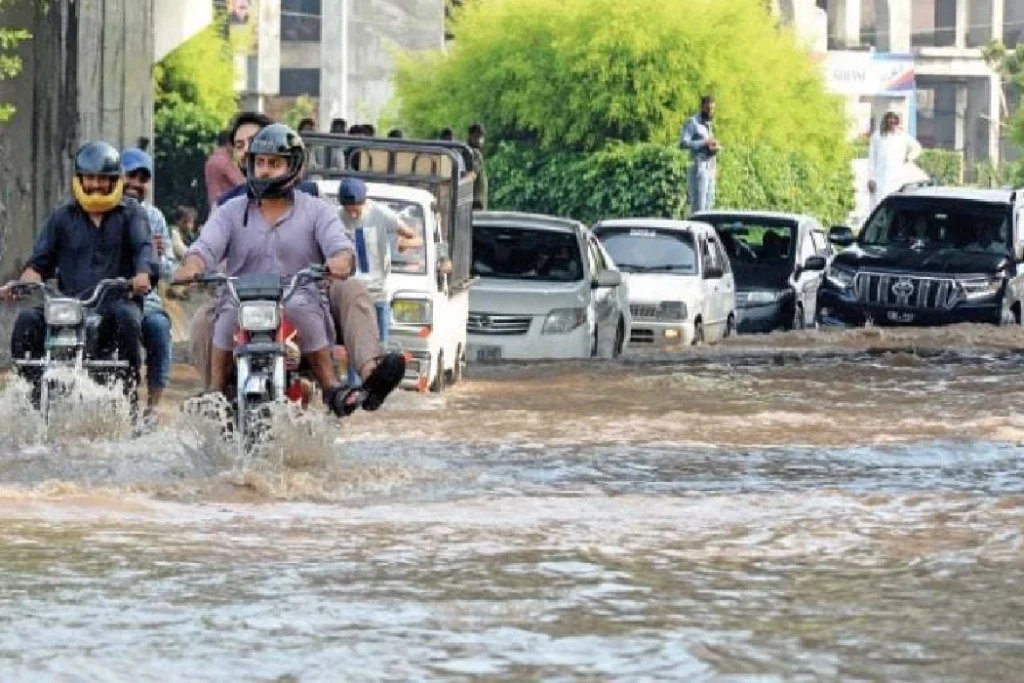In the wake of persistent and heavy monsoon rains across Islamabad and Rawalpindi, the water level in Nullah Lai has risen to critical heights, crossing the officially designated danger level and prompting city authorities to issue urgent evacuation orders for residents in nearby areas. The alarming surge in water level has turned parts of the twin cities into potential flood zones, triggering a full-scale emergency response by the district administration and disaster management authorities.
According to officials monitoring the situation, the water level in Nullah Lai reached approximately 19 feet at Katarian and 18 feet at Gawalmandi, both of which exceed the safety threshold. These levels were recorded after several hours of uninterrupted rainfall, which overwhelmed the region’s drainage capacity and caused rapid inflow into the channel.
The continuous downpour was particularly intense in areas such as Shamsabad, Bokra, and Golra, where rainfall levels reached between 112 to 195 millimeters in a span of just a few hours. The volume of water quickly exceeded the channel’s carrying capacity, leading to fears of overflow and flash flooding in the low-lying residential neighborhoods located along Nullah Lai’s banks.
Emergency Measures Enacted
In response, the Rawalpindi District Administration, in coordination with the Rescue 1122, WASA, law enforcement agencies, and the Provincial Disaster Management Authority (PDMA), initiated an immediate evacuation operation. Loudspeakers, sirens, and mobile units were deployed across high-risk neighborhoods to instruct residents to vacate their homes and proceed to safer, higher ground. In multiple areas, schools and community halls have been transformed into temporary flood relief shelters, providing emergency lodging, food, and medical care to affected families.
The district authorities also directed the activation of the flood control room, which is now functioning round-the-clock to monitor telemetry data and coordinate rescue operations. Officials on the ground have been instructed to enforce precautionary measures and evacuate those who remain in danger zones.
Infrastructure Response and Drainage Management
At the same time, WASA field units have been deployed to clear debris from stormwater drains, reinforce embankments with sandbags, and ensure the flow of water through the stormwater drainage systems remains unblocked. Heavy machinery has been moved to strategic points to remove obstructions and manage any incidents of water pooling on city roads and underpasses. WASA teams have also been dispatched to inspect vulnerable spots where the water pressure is likely to cause breaches in the embankment or result in water entering residential zones.
Additionally, coordination with the Islamabad administration is underway to manage the upper catchment flow that feeds into Nullah Lai, particularly during periods of rainfall in the capital’s hilly zones, which contributes significantly to water levels downstream in Rawalpindi.
Nullah Lai’s Geographical Risk Profile
Stretching approximately 30 kilometers, Nullah Lai originates from the Margalla Hills in Islamabad and flows through the heart of Rawalpindi, absorbing water from multiple tributaries before draining into the Soan River. Due to the area’s bowl-like geography and high-density urban construction, Nullah Lai is especially prone to rapid overflow during heavy rains.
The stream passes through densely populated localities including Dhok Ratta, Sadiqabad, New Katarian, Gawalmandi, and Dhok Hassu all of which are areas that historically face the brunt of flooding during monsoon season. Over the past two decades, several devastating floods have occurred along the Nullah’s course, including the infamous 2001 flood, which resulted in numerous casualties and significant property loss.
Public Warnings and Safety Advisory
As the situation continues to evolve, authorities have issued a strong advisory for the public:
- Residents in flood-prone areas should comply with evacuation notices and relocate to emergency shelters.
- People should avoid walking or driving through fast-flowing water, even if it appears shallow.
- Residents are advised to keep emergency kits, important documents, and valuables in waterproof containers.
- Families should maintain communication with local rescue teams and inform them immediately of any trapped individuals, especially elderly or disabled residents.
- Schools, mosques, and local volunteers are being urged to support in emergency shelter management and aid distribution.
Local law enforcement and volunteers have been mobilized to assist elderly residents, distribute food and clean drinking water, and provide medical aid to those in need. Health workers are also on alert to prevent the spread of waterborne diseases, which often follow flooding events in urban centers.
Long-Term Resilience and Infrastructure Planning
The latest crisis has reignited debate about the need for a long-term urban flood management strategy in Rawalpindi. Despite previous efforts to widen and straighten parts of Nullah Lai and clear illegal encroachments along its banks, experts argue that insufficient attention has been given to stormwater management, urban planning, and early warning systems.
Proposals for nullah remodeling, floodplain zoning, and underground drainage expansion have been repeatedly discussed, yet much of the structural work remains either incomplete or poorly maintained. As climate change continues to intensify rainfall patterns and increase the frequency of extreme weather events, the need for sustainable and scientifically-informed urban planning has become more urgent than ever.
In addition, stronger coordination among departments such as meteorological services, water supply agencies, and local governments is essential for better forecasting and disaster preparedness. Public education campaigns must also be enhanced so communities understand flood risks and act swiftly when evacuation orders are issued.
Conclusion
The surge in Nullah Lai’s water level is a sobering reminder of the challenges posed by unregulated urban expansion, inadequate drainage infrastructure, and climate-driven weather extremes. While timely action by the authorities has helped minimize immediate harm, the broader lesson remains: without comprehensive structural reforms, cities like Rawalpindi will remain vulnerable to seasonal flooding and its devastating consequences.
As the situation stabilizes and waters begin to recede, attention must now turn to rebuilding, rehabilitating displaced families, and implementing long-term resilience measures to protect lives and livelihoods in the future. The monsoon season is far from over, and preparedness must remain the government’s top priority.



Comments (0)
No comments yet. Be the first to comment!
Leave a Comment